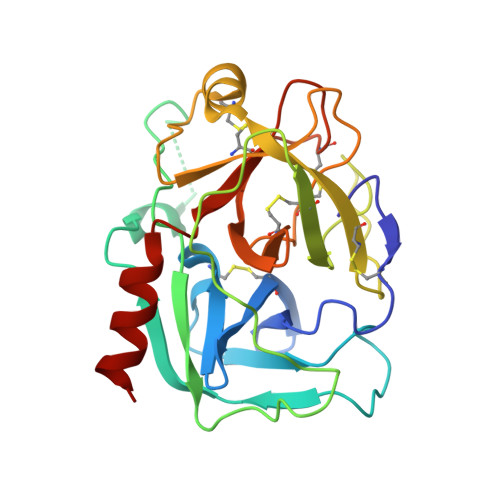1.70 A X-ray structure of human apo kallikrein 1: Structural changes upon peptide inhibitor/substrate binding
Laxmikanthan, G., Blaber, S.I., Bernett, M.J., Scarisbrick, I.A., Juliano, M.A., Blaber, M.(2005) Proteins 58: 802-814
- PubMed: 15651049
- DOI: https://doi.org/10.1002/prot.20368
- Primary Citation of Related Structures:
1SPJ - PubMed Abstract:
Human kallikreins are serine proteases that comprise a recently identified large and closely related 15-member family. The kallikreins include both regulatory- and degradative-type proteases, impacting a variety of physiological processes including regulation of blood pressure, neuronal health, and the inflammatory response. While the function of the majority of the kallikreins remains to be elucidated, two members are useful biomarkers for prostate cancer and several others are potentially useful biomarkers for breast cancer, Alzheimer's, and Parkinson's disease. Human tissue kallikrein (human K1) is the best functionally characterized member of this family, and is known to play an important role in blood pressure regulation. As part of this function, human K1 exhibits unique dual-substrate specificity in hydrolyzing low molecular weight kininogen between both Arg-Ser and Met-Lys sequences. We report the X-ray crystal structure of mature, active recombinant human apo K1 at 1.70 A resolution. The active site exhibits structural features intermediate between that of apo and pro forms of known kallikrein structures. The S2 to S2' pockets demonstrate a variety of conformational changes in comparison to the porcine homolog of K1 in complex with peptide inhibitors, including the displacement of an extensive solvent network. These results indicate that the binding of a peptide substrate contributes to a structural rearrangement of the active-site Ser 195 resulting in a catalytically competent juxtaposition with the active-site His 57. The solvent networks within the S1 and S1' pockets suggest how the Arg-Ser and Met-Lys dual substrate specificity of human K1 is accommodated.
Organizational Affiliation:
Institute of Molecular Biophysics Florida State University, Tallahassee, Florida 32306-3015, USA.

















